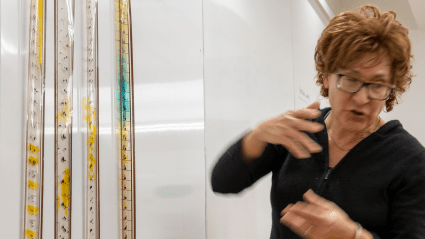Cameraless Animation Workshop and Artist Talk
Mount Holyoke’s Arts and Technology Initiative, the film studies department, and the Fimbel Maker and Innovation Lab sponsored an artist talk and hands-on workshop by Boston independent filmmaker Gina Kamentsky.
Mount Holyoke’s Arts and Technology Initiative, the film studies department, and the Fimbel Maker and Innovation Lab sponsored an artist talk and hands-on workshop by Boston independent filmmaker Gina Kamentsky.

In a one-hour artist talk, Gina showed 11 films (they’re short!), discussing the process and circumstances of each production. Most of these were created using a camera-less direct animation process, with content drawn and painted directly on motion picture film. Some films also incorporated imagery that Gina manually traced from other video sources (the film “Spank Shot” drew its imagery from found footage of hockey fights, for example) using an iPhone-to-film system of her own devising. She also brought some samples of original artwork, on 70mm film, for students to inspect.
About 12 students and four faculty and staff were in attendance, and a lively Q&A session followed.
For the subsequent workshop, we arranged the Fimbel Lab’s worktables end-to-end to form a 30-foot-long continuous work surface. Rolls of clear and black 16mm film were unspooled along the tables and each of the 10 students participating was assigned a 5-foot segment of both film stocks. For the next 90 minutes or so, the students experimented with marking the fingernail-sized film frames using various pens, inks and scratching tools. The final results were spliced together and loaded into the 16mm projector.
The students watched their film — several times, including backwards — in saucer-eyed amazement. For those three minutes, it was as if they were an audience seeing cinema for the first time in 1895. Like most of their age cohort, these students have consumed and made staggering numbers of digital videos in their lives, using easily available technology. But the direct-animation technique made the moving image tangible in a way that digital media doesn’t.
The experience also illuminated one of the digital era’s ironies: While instant video production and global distribution are unremarkable features of daily existence — enabled by technologies that are somehow both mysterious and boring — an hour or two of hands-on engagement with the physical material of motion picture film puts the magic back into the medium.